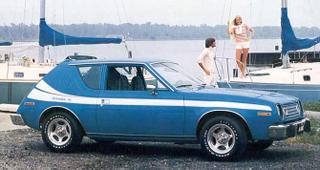




The name of this car is sufficient to describe it's fugliness.
The AMC Gremlin was introduced in early 1970 as a 1970-1/2 model. It was the result of a fast track program to bring the first modern, U.S.-built subcompact car to market. AMC was successful in beating both GM and Ford to the punch, since the Chevrolet Vega and Ford Pinto were introduced as 1971 models. However in doing this they cut corners which were the downfall of the car and it's semi-successor, the Pacer.
By 1970, AMC had become a car company that was trying to be all things to all people, instead of concentrating on the economy end of the market as had been done successfully during the late 1950s and early '60s. The trouble was, AMC was the smallest of the U.S. auto companies and could least afford the tremendous costs associated with developing new vehicles.
Perhaps the most significant car in AMC's 1970 line-up was the Hornet , which was basically a replacement for the successful Rambler American series. In many respects, the Hornet was a very up-to-date car, even though it used a number of mechanical pieces from the Rambler.
The Hornet would be the basis for several AMC vehicles through the years, including the Concord and the all-wheel-drive Eagle which carried the company through the 80's to it's death which may be featured later for their own brand of fugliness.
Within six months of its own introduction, the Hornet had already spawned the Gremlin - evidence that in order to beat Ford and Chev they may have sacrificed too much in means of development time and thinking. AMC's "distinctively-styled" subcompact's basic design was penned on the back of a Northwest Orient air sickness bag (appropriately enough) only about 18 months before the car was introduced.
The late designer, Richard Teague was responsible for the design. The end product combined many of the rear-end styling features of the 1967 AMX/GT show car with the more mundane front end hardware of the production Hornet. The result of these two styles created it's controversial looking rear end - it looks as if someone cut off the back of the car with a cleaver. Only accentuating this was smaller rear quarter windows, which must have made backing up fun.
There were two basic Gremlin models offered for 1970: a bare-bones, fixed window two-seater (targeted as an import-fighting price leader) and a four-seater, which added a flip-up rear window hatch. One of the Gremlin's major selling points was its powertrain. While the rest of the subcompact competition had to make do with four-cylinder motivation, the first year Gremlin came equipped with either of two in-line, six-cylinder engines: a 128 horsepower 199 cubic inch (3.3L) engine was standard, while a 145 horsepower, 232 (3.8L) cubic inch version was optional. The same engines offered in - shock - the Hornet.
Because of the extra cubes and torque provided by the large six-cylinder engines, Gremlin's performance was quite sprightly, especially in comparison with the rest of the subcompact competition. However, this made the car a bit of an oxymoron. This was meant to be a compact car which was born because of the oil crisis and Asian competition. Cutting the rear end off a large car to make a smaller (but still wide) one and using the same big engines does not a economy car make. To make matters worse (or better for the power hungry) the smaller engine was dropped in 1971.
Another thing that added to the Gremlin's "unique" look was the X package offered for the first time in 1971. This package consisted of special "spear" striping on the body sides, body color grille surround, larger 14" blackwall tires mounted on slotted alloy wheels (raised white letter tires were optional), space-saver spare tire, custom interior trim including bucket seats, "engine turned" instrument trim, and special "X" decals. The rear deck inset panel containing the taillights received a full width decal (same colour as the striping) as part of the "X" package.
'72 saw a V8 option for the "economy" car - a 304 cubic inch unit that made 150hp. '73 saw more changes to the exterior to comply with safety laws adding large and uglier bumpers. A "Levi's" edition was also added, which added classy demin seats and other demin interior accents. Although most of the changes made the car look worse and worse (like the larger taillights) the last front end was a slight emprovement. Last year of production was 1978, which oddly allowed a three year overlap of AMC dealerships offering both this and the Pacer.
Above information was found on allpar.com, and editted by myself for length and content.








No comments:
Post a Comment